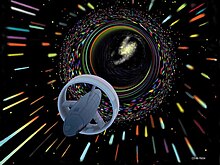This article needs additional citations for verification. (January 2017) |
| Wormhole | |
|---|---|
 Artist's impression of wormhole travel | |
| Created by | Einstein–Rosen |
| Genre | Science fiction |
| In-universe information | |
| Location | Space |
| Type | Transportation |
| Classification | Pseudo-scientific fiction |
| First proposed | 1916 |
| Re-proposed | 1935 |
| Spatial anomalies in fiction |
|---|
|
Black holes in fiction • Portable hole • Teleportation in fiction • Wormholes in fiction • Stargate • Warp drive • Hyperspace • Time travel in fiction |
|
|
 |
| Speculative fiction |
|---|
|
|
A wormhole is a postulated method, within the general theory of relativity, of moving from one point in space to another without crossing the space between.[1][2][3][4] Wormholes are a popular feature of science fiction as they allow faster-than-light interstellar travel within human timescales.[5][6][7]
A related concept in various fictional genres is the portable hole. While there's no clear demarcation between the two, this article deals with fictional, but pseudo-scientific, treatments of faster-than-light travel through space.
A jumpgate is a fictional device able to create an Einstein–Rosen bridge portal (or wormhole), allowing fast travel between two points in space.
- ^ Taylor Redd, Nola (October 21, 2017). "What is a Wormhole?". Space.com. Retrieved September 8, 2018.
- ^ Siegfried, Tom (August 19, 2016). "A new 'Einstein' equation suggests wormholes hold key to quantum gravity". Science News. Retrieved September 8, 2018.
- ^ Einstein, A.; Rosen, N. (July 1, 1935). "The Particle Problem in the General Theory of Relativity". Physical Review. 48 (1): 73–77. Bibcode:1935PhRv...48...73E. doi:10.1103/physrev.48.73. ISSN 0031-899X.
- ^ Maldacena, Juan (2013). "Entanglement and the Geometry of Spacetime". Institute for Advanced Study. Retrieved September 8, 2018.
- ^ Crothers, Stephen J. (October 3, 2014). "Wormholes and Science Fiction". Thunderbolts Project.
- ^ Grush, Loren (October 26, 2014). "What is a Wormhole and Will Wormhole Travel Ever be Possible?". Popular Science. Retrieved March 7, 2019.
- ^ Veggeberg, Scott (July 1992). "Cosmic Wormholes: Where Science Meets Science Fiction". The Scientist Magazine. Retrieved March 7, 2019.
